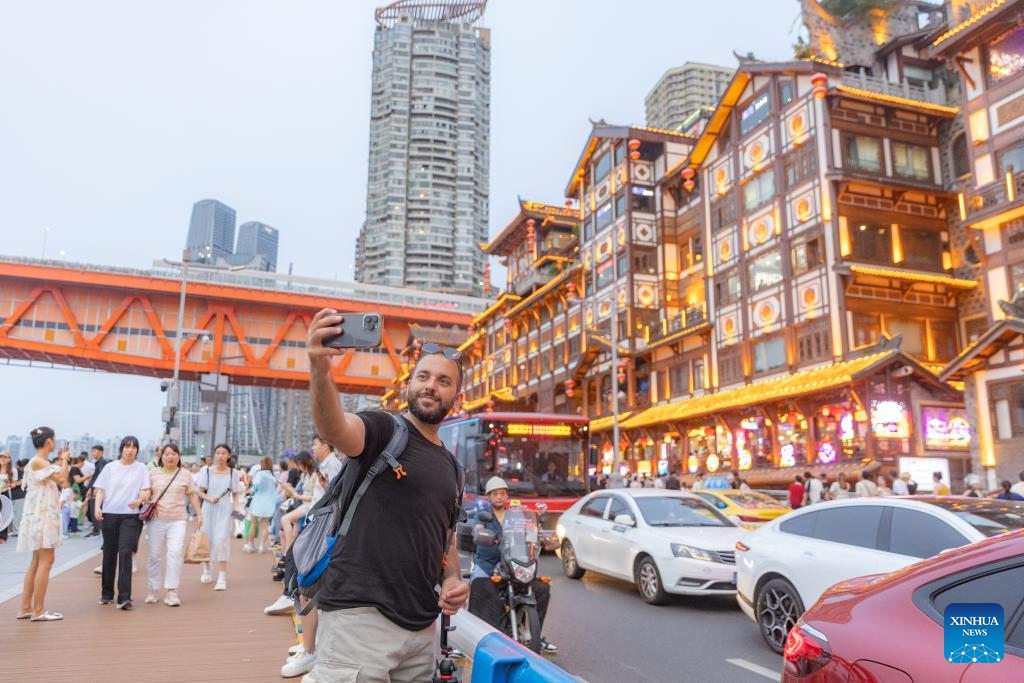Travel
144-hour visa-free transit policy triggers ‘China Travel’ boom

A tourist from Pakistan take a selfie at Hongyadong scenic area in Yuzhong district, in southwest China’s Chongqing, July 8, 2024. Chongqing has handled more than 150,000 inbound and outbound foreign passengers in the first half of this year, 4.9 times that of the same period last year. With optimized visa policies, Chongqing keeps on improving the itinerary management for inbound tour groups, offering foreign travelers more flexible choices on the ports of entry and exit. Photo: Xinhua
“The 144-hour visa-free transit policy is incredibly convenient. I really want to come to China again!” A South Korean visitor told the Global Times after his recent visit to China.
With China’s more friendly visa policy for foreign visitors put in place, a surge of “China Travel” excitement has been ignited, leading to a growing number of foreign bloggers eagerly sharing their travel experiences in China on various social media platforms.
As more foreigners are flocking to China, thanks to the facilitating measures, and share their authentic feelings, a true, multidimensional and panoramic view of China will be increasingly seen and understood by the international community, analysts said.
According to China’s National Immigration Administration (NIA), the total number of visa-free entries made by eligible foreigners exceeded 8.54 million in the first six months of 2024, accounting for 52 percent of the inbound trips during the period and representing a year-on-year growth of 190.1 percent.
The 144-hour visa-free transit policy is seen as a crucial step in attracting a growing number of international visitors to China, as it has propelled “China Travel” to the forefront of trending topics on both domestic and international social media platforms, with numerous captivating travel videos featuring foreigners exploring China being shared across the globe.
Koh Junho, a South Korean tourist who has shared his experience with visa-free entry and travel in China on Xiaohongshu, a Chinese equivalent to Instagram, told the Global Times on Monday that the 144-hour visa-free transit policy makes border entry super convenient and not as challenging as he had initially imagined at all.
“Before my trip to China in June, I was quite nervous because I was worried about what kind of difficulties I would encounter at the border control department. However, after explaining to airport staff that I intended to enter China using the 144-hour visa-free transit policy, everything went quite smoothly afterward,” he said.
During his trip, Koh visited Shanghai, as well as Hangzhou in East China’s Zhejiang Province, both of which left a deep impression on him. “I really want to visit China again,” Koh told the Global Times.
Koh is just one of the many foreigners attracted to China.
“This is my first time in China, but I have been completely fascinated by the country.” “China is the safest country I have ever been to, and people are very friendly and helpful.” “My last wish is to be in China forever.” Loads of similar posts and comments are flooding social media platforms.
Dai Bin, president of the China Tourism Academy, told the Global Times on Monday that the 144-hour visa-free transit policy has played a positive role in the development of inbound tourism in China, and at the same time, it is very helpful for foreigners to gain a true, multidimensional and panoramic view of China.
Dai noted that foreigners coming to China can not only see the country’s stunning natural landscapes, but also gain a deeper understanding of China’s remarkable progress and achievements across a wide range of fields.
“Seeing is believing. Only by coming to China in person and gaining first-hand experience can one break prejudices, and thereby fostering genuine people-to-people exchanges and communications,” Dai said.
In a move to further facilitate international travel, China announced on Monday the expansion of its 144-hour visa-free transit policy to three additional entry ports, taking the number of Chinese ports covered by the policy to 37.
The three new ports are Zhengzhou Xinzheng International Airport in Central China’s Henan Province, Lijiang Sanyi International Airport in Southwest China’s Yunnan Province, and the Mohan railway port in Yunnan, the NIA said in a statement. The move marks China’s ramped-up effort to the commitment of high-level opening-up, analysts said.
In response to the popularization of foreign vloggers sharing on the internet their traveling experiences in China, Mao Ning, spokesperson of the Chinese Foreign Ministry, said on July 4 that it’s great to see foreign friends enjoy the lovely scenery and delicacies that China has to offer, and experience the vibrancy of China as it is.
“We will take more steps to make travel simpler and more enjoyable for our foreign friends. China’s always ready to welcome friends from around the world with open arms,” Mao said at the routine press conference.
“With the facilitating measures in visa, payment, and other aspects, I have full confidence that ‘China Travel’ will have greater development,” Dai said.










